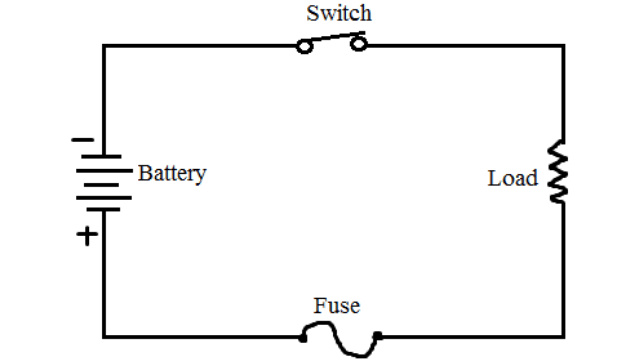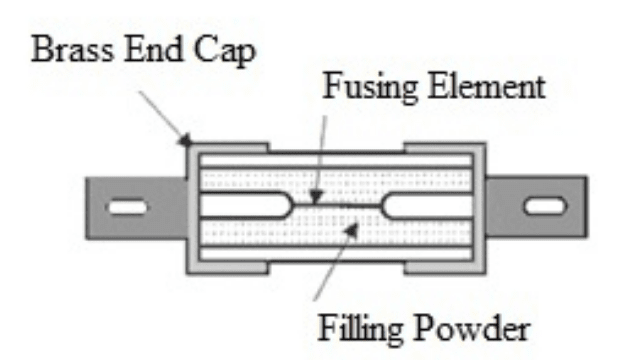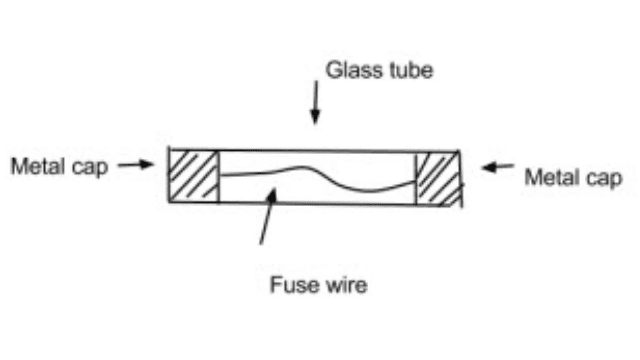
Table of Contents
What is Fuse
In normal working condition of electrical network, the electric current flows through the network is within the rated limits but when a fault occurs the heating effect of current may damage the electrical circuit. So, to protect in the circuit from these faults fuses are used in the phase wire, so that it melts itself and protect the circuit from damage. In another way we can say that, the fuse is the current interrupting devices which break or open the circuit by fusing the element and does remove the faulty device from the main supply circuit. In electronics and electrical engineering a fuse is an electrical safety device that operates to provide overcurrent protection of an electric circuit.

Types of fuse
Fuse are mainly of three types :
- Kit-kat fuse
- HRC fuse
- Cartridge fuse
1. Kit-kat fuse
Kit Kat fuse is rewirable semi enclosed fuse developed primarily for residential wiring and small-scale applications this is most commonly used fuse this use consists of two parts one is base and second part is from carrier the base is fixed in the face wire and the fuse carrier contain the fuse wire fixed in it. When normal value of current flows to the circuit they have no effect on the fuse wire. But when abnormal current flows to the fuse wire it melts & thus protect the circuit from damage.

The fuse carrier is then rewired again. The material used in fuse wire are lead, tin, copper, aluminium, zinc, silver, etc. And thus it is also called as rewirable fuse.
Advantages of kit-kat fuse
- They are cheaper.
- kit-kat fuse is easy to install.
- kit-kat fuse can be used again after blowing off the fuse element.
- kit-kat fuse is easy to remove & replace at negligible cost.
Disadvantages of kit-kat fuse
- Unreliable Operation because for the working of the fuse it is essential to choose the element of suitable size capacity.
- Low rupturing capacity
- The breaking capacity of fuse is limited.
- Slow speed of operation.
- The arcing time of fuse is very high.
2. HRC fuse
The full form of HRC is high rupturing capacity fuse. These fuses are used to interrupt heavy current. It consist of ceramic body having metallic ends to which fusible silver element is connected. The space within the body is surrounded by filling power i.e. quartz, it is used to extinguish the arc. The HRC fuse has to be replaced fully after every fault. Means this fuse cannot be rewire. The rating of HRC fuse upto1250amp. They are generally larger then screw types fuses, and have ferrule cap blade or contacts.

Advantages of HRC Fuse
- It is very simple and easy to install .
- It is a maintenance free fuse.
- High speed operation.
- It provides reliable discrimination.
- The operation is very quick.
- It is capable to clear high as well as low fault current.
- It gives you a reliable performance for a long time
Disadvantages of HRC Fuse
- This has to be replaced after each operation.
- Interlocking is not possible.
- Heat being produced by the arc may affect the associated switches.
- Fuse is slow as compared to circuit breakers.
3. Cartridge Fuse
These fuses are used to electronic circuit. The fuse wire is enclosed in a transparent glass tube which is sealed. These fuses can not be rewired but they have been replaced. A cartridge fuse is a cylinder shaped fuse with either metal caps (ferrules) or blade contact points, at both ends. Most cartridge fuses are rated for 250 Volt to 600 Volt circuits, dependent on the class of the fuse, and rated for varying amperages as high as 600 amps, again dependent on the specific fuse.

Advantages of cartridge fuse
- Cartridge fuse has a high breaking capacity.
- It has good selectivity values.
- It is easy to replace.
- It’s operation is fast.
- Cartridge fuse is a low-cost solution.
- It can be used in low and high temperatures.
Disadvantages of cartridge fuse
- Lack of accessories.
- It is old technology.
- Most of them should be used with a fuse carrier.
- Slow recovery time on a trip.
- Time is lost in replacing fuses after operation.
Frequently Asked Questions (FAQ)
What is fuses?
Fuse is a device used to protect the circuit from faults under abnormal conditions. Fuse are used in the phase wire, so that it melts itself and protect the circuit from damage.
What are the main types of fuse?
Fuses are mainly of three types :
(1) Kit-Kat fuse
(2) HRC fuse
(3) Cartridge fuseWhat is the purpose of fuse?
In electronics and electrical engineering, a fuse is an electrical safety device that operates to provide over-current protection of an electric circuit. The main purpose of fuse is used to protect the circuit under abnormal conditions.
What is fuse box?
Fuse box are used in vehicles for protecting the electrical & electronics components. The box is designed to cut off electricity to one of the circuits in case of overload on the circuit indicating an electric short.
Read Also :
- MCB : Miniature Circuit Breaker
- Circuit Breaker | Types of Circuit Breaker
- Different Types of Faults in Overhead Transmission Lines





Comments (2)
It’s remarkable in favor of me to have a website,
which is good designed for my know-how. thanks admin
I am regular visitor, how are you everybody? This post posted at this
web page is truly nice.